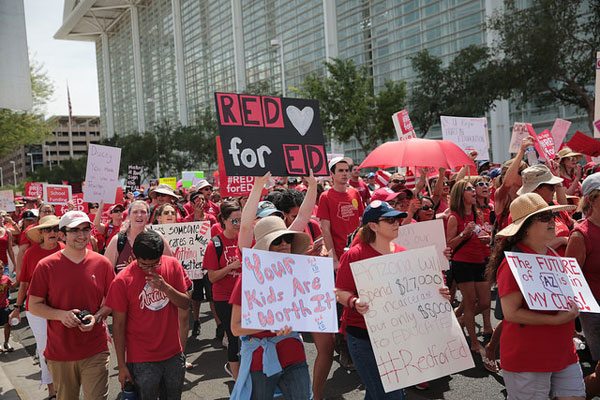
May 3, 2018; USA Today
Arizona’s teachers are returning to work after a six-day teacher walkout, the first statewide teacher walkout in Arizona history. The initial results include considerable salary gains for teachers—an average nine-percent raise the coming fiscal year, with promises of two additional five-percent increases in the next two years. The budget also, reports Reuters, “lifts school funding by $371 million over five years.
While falling short of teacher demands for a 20-percent increase in one year and a full restoration of $1.1 billion in reduced school funding over the past decade, the final budget did give Arizona schools and teachers far more than the budget Governor Doug Ducey originally tabled, which had included only a one-percent salary increase.
Teacher salaries in Arizona are low. “The state’s average teacher’s salary was $47,403, eighth lowest in the country,” note Lily Altavena, Richard Ruelas, and Rachel Leingang in USA Today, “compared to a national average of $59,660.”
Altavena and her colleagues emphasize that more than pay is at issue. The teachers also sought “a reversal of the $1 billion in cuts made to the state education budget in the past decade, a halting of tax cuts until the state per-pupil monies reach the national average and raises for school support staff.”
Sign up for our free newsletters
Subscribe to NPQ's newsletters to have our top stories delivered directly to your inbox.
By signing up, you agree to our privacy policy and terms of use, and to receive messages from NPQ and our partners.
Here, it is worth emphasizing that there is indeed considerable ground to make up. According to a recent report by the Center on Budget and Policy Priorities (CBPP), state funding per pupil in Arizona fell 36.6 percent in inflation-adjusted dollars between 2008 and 2015, the largest decline of any US state. As Altavena and her colleagues point out, “Arizona’s 2017 per-pupil expenditures were $7,501, more than $4,000 per student below the national average of $11,642, according to a National Education Association report.
Due to some increases in state funding since 2015 and increased local funding, overall general or formula funding per student in Arizona in fiscal-year 2018 was a more modest 13.6 percent less than 2008, a still considerable decline. The loss works out to total more than $1,000 per student (the 2008 per student funding level in Arizona was $8,580, according to Arizona School Boards Association). Notably, four states that have been among the leaders of what some have called the nation’s education spring—West Virginia, Kentucky, Oklahoma, and Arizona—all fall in the top six of CBPP’s list of states with the largest per-pupil funding declines over the past decade.
As the state school board association explains, the impacts of the funding cutbacks have been widespread. For example, full-day kindergarten was eliminated in Arizona in 2011 and schools have also suffered what has amounted to a $2 billion cut in capital funds. All told, the funding loss totals $4.6 billion, the school board association estimates. The association also notes that—beyond the above-listed cuts and reduced teacher salaries—additional impacts have included:
- Teachers and other school staff were laid off.
- Arizona went from a teacher surplus to a teacher shortage.
- Class sizes increased.
- Educational programs were dropped.
- School buildings and buses could not be maintained.
- Textbook adoptions were delayed and curriculum could not be updated.
While not all of the lost funding has been restored, the spending increases contained in the new state budget do give Arizona teachers and the #RedforEd movement considerable momentum. David Schwartz reports for Reuters that walkout organizers, such as Noah Karvelis, a music teacher in the Phoenix-area suburb of Tolleson and leader of Arizona Educators United, “have turned their attention to a November ballot initiative to raise $690 million annually through a tax hike on the state’s highest earners. The initiative proposes creating a dedicated stream of education funding that lawmakers cannot use to balance the budget or for other spending.”
“The war is not over but we’ve won an important battle to move the legislature this far,” Karvelis said.—Steve Dubb











